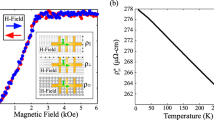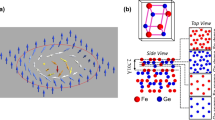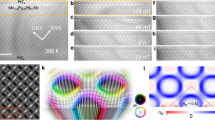Abstract
Chiral magnetic skyrmions1,2 are nanoscale vortex-like spin textures that form in the presence of an applied magnetic field in ferromagnets that support the Dzyaloshinskii–Moriya interaction (DMI) because of strong spin–orbit coupling and broken inversion symmetry of the crystal3,4. In sharp contrast to other systems5,6 that allow for the formation of a variety of two-dimensional (2D) skyrmions, in chiral magnets the presence of the DMI commonly prevents the stability and coexistence of topological excitations of different types7. Recently, a new type of localized particle-like object—the chiral bobber (ChB)—was predicted theoretically in such materials8. However, its existence has not yet been verified experimentally. Here, we report the direct observation of ChBs in thin films of B20-type FeGe by means of quantitative off-axis electron holography (EH). We identify the part of the temperature–magnetic field phase diagram in which ChBs exist and distinguish two mechanisms for their nucleation. Furthermore, we show that ChBs are able to coexist with skyrmions over a wide range of parameters, which suggests their possible practical applications in novel magnetic solid-state memory devices, in which a stream of binary data bits can be encoded by a sequence of skyrmions and bobbers.
This is a preview of subscription content, access via your institution
Access options
Access Nature and 54 other Nature Portfolio journals
Get Nature+, our best-value online-access subscription
$29.99 / 30 days
cancel any time
Subscribe to this journal
Receive 12 print issues and online access
$259.00 per year
only $21.58 per issue
Buy this article
- Purchase on Springer Link
- Instant access to full article PDF
Prices may be subject to local taxes which are calculated during checkout




Similar content being viewed by others
References
Bogdanov, A. N. & Yablonskii, D. A. Thermodynamically stable ‘vortices’ in magnetically ordered crystals. The mixed state of magnets. Sov. Phys. JETP 68, 101 (1989).
Ivanov, B. A., Stephanovich, V. A. & Zhmudskii, A. A. Magnetic vortices—the microscopic analogs of magnetic bubbles. J. Magn. Magn. Mater. 88, 116 (1990).
Dzyaloshinskii, I. A thermodynamic theory of ‘weak’ ferromagnetism of antiferromagnetics. J. Phys. Chem. Solids 4, 241–255 (1958).
Moriya, T. Anisotropic superexchange interaction and weak ferromagnetism. Phys. Rev. 120, 91–98 (1960).
Belavin, A. A. & Polyakov, A. M. Metastable states of two-dimensional isotropic ferromagnets. JETP Lett. 22, 245 (1975).
Piette, B. M. A. G., Schroers, B. J. & Zakrzewski, W. J. Multisolitons in a two-dimensional Skyrme model. Z. Phys. C. 65, 165–174 (1995).
Koshibae, W. & Nagaosa, N. Theory of antiskyrmions in magnets. Nat. Commun. 7, 10542 (2016).
Rybakov, F. N., Borisov, A. B., Blügel, S. & Kiselev, N. S. New type of particlelike state in chiral magnets. Phys. Rev. Lett. 115, 117201 (2015).
Kanazawa, N., Seki, S. & Tokura, Y. Noncentrosymmetric magnets hosting magnetic skyrmions. Adv. Mater. 29, 1603227 (2017).
Yu, X. et al. Variation of skyrmion forms and their stability in MnSi thin plates. Phys. Rev. B 91, 054411 (2015).
Yu, X. Z. et al. Near room-temperature formation of a skyrmion crystal in thin-films of the helimagnet FeGe. Nat. Mater. 10, 106–109 (2011).
Yu, X. Z. et al. Real space observation of a two-dimensional skyrmion crystal. Nature 465, 901–904 (2010).
Shibata, K. et al. Towards control of the size and helicity of skyrmions in helimagnetic alloys by spin–orbit coupling. Nat. Nanotech. 8, 723–728 (2013).
Tokunaga, Y. et al. A new class of chiral materials hosting magnetic skyrmions beyond room temperature. Nat. Commun. 6, 7638 (2015).
Li, W. et al. Emergence of skyrmions from rich parent phases in the molybdenum nitrides. Phys. Rev. B 93, 060409 (2016).
Dzyaloshinskii, I. E. Theory of helicoidal structures in antiferromagnets. III. Sov. Phys. JETP 20, 665 (1965).
Lebech, B., Bernhard, J. & Freltoft, T. Magnetic structures of cubic FeGe studied by small-angle neutron scattering. J. Phys. Condens. Matter 35, 6105 (1989).
Rybakov, F. N., Borisov, A. B. & Bogdanov, A. N. Three-dimensional skyrmion states in thin films of cubic helimagnets. Phys. Rev. B 87, 094424 (2013).
Rybakov, F. N., Borisov, A. B., Blügel, S. & Kiselev, N. S. New spiral states and skyrmion lattice in 3D model of chiral magnet. New. J. Phys. 18, 045002 (2016).
Romming, N., Kubetzka, A., Hanneken, C., von Bergmann, K. & Wiesendanger, R. Field-dependent size and shape of single magnetic skyrmions. Phys. Rev. Lett. 114, 177203 (2015).
Boulle, O. et al. Room-temperature chiral magnetic skyrmions in ultrathin magnetic nanostructures. Nat. Nanotech. 11, 449–454 (2016).
Kiselev, N. S., Bogdanov, A. N., Schäfer, R. & Rößler, U. K. Chiral skyrmions in thin magnetic films: new objects for magnetic storage technologies? J. Phys. D. 44, 392001 (2011).
Fert, A., Cros, V. & Sampaio, J. Skyrmions on the track. Nat. Nanotech. 8, 152–156 (2013).
Midgley, P. A. & Dunin-Borkowski, R. E. Electron tomography and holography in materials science. Nat. Mater. 4, 271–280 (2009).
Park, H. S. et al. Observation of the magnetic flux and three-dimensional structure of skyrmion lattices by electron holography. Nat. Nanotech. 9, 337–342 (2014).
Milde, P. et al. Unwinding of a skyrmion lattice by magnetic monopoles. Science 340, 1076–1080 (2013).
Schütte, C. & Rosch, A. Dynamics and energetics of emergent magnetic monopoles in chiral magnets. Phys. Rev. B 90, 174432 (2014).
Leonov, A. O., Monchesky, T. L., Loudon, J. C. & Bogdanov, A. N. Three-dimensional chiral skyrmions with attractive interparticle interactions. J. Phys. Condens. Matter 28, 35 (2016).
Ahmed, A. S. et al. Chiral bobber formation in epitaxial FeGe/Si(111) films. Preprint at http://arXiv.org/abs/1706.08248v1 (2017).
Du, H. et al. Edge-mediated skyrmion chain and its collective dynamics in a confined geometry. Nat. Commun. 6, 8504 (2015).
Jin, C. et al. Control of morphology and formation of highly geometrically confined magnetic skyrmions. Nat. Commun. 8, 15569 (2017).
Chang, S. L. Y., Dwyer, C., Barthel, J., Boothroyd, C. B. & Dunin-Borkowski, R. E. Performance of a direct detection camera for off-axis electron holography. Ultramicroscopy 161, 90–97 (2016).
Voelkl, E. & Tang, D. Approaching routine 2π/1000 phase resolution for off-axis electron holography. Ultramicroscopy 110, 447–459 (2010).
McLeod, R. A., Bergen, M. & Malac, M. Phase measurement error in summation of electron holography series. Ultramicroscopy 141, 38–50 (2014).
Lichte, H. & Lehmann, M. Electron holography—basics and applications. Rep. Prog. Phys. 71, 016102 (2008).
Vansteenkiste, A. et al. The design and verification of MuMax3. AIP Adv. 4, 107133 (2014).
Shibata, K. et al. Temperature and magnetic field dependence of the internal and lattice structures of skyrmions by off-axis electron holography. Phys. Rev. Lett. 118, 087202 (2017).
Döring, W. Point singularities in micromagnetism. J. Appl. Phys. 39, 1006 (1968).
Thiaville, A., Garca, J. M., Dittrich, R., Miltat, J. & Schrefl, T. Micromagnetic study of Bloch-point-mediated vortex core reversal. Phys. Rev. B 67, 094410 (2003).
Zverev, V. V. & Filippov, B. N. Simulation of three-dimensional micromagnetic structures in magnetically uniaxial films with in-plane anisotropy: static structures. Phys. Met. Metallogr. 114, 108–115 (2013).
Mansuripur, M. Computation of electron diffraction patterns in Lorentz electron microscopy of thin magnetic films. J. Appl. Phys. 69, 2455–2464 (1991).
Kovács, A. et al. Mapping the magnetization fine structure of a lattice of Bloch-type skyrmions in an FeGe thin film. Appl. Phys. Lett. 111, 192410 (2017).
Acknowledgements
This work was supported by the National Key R&D Program of China, grant no. 2017YFA0303201, the Natural Science Foundation of China, grant nos 51622105 and 11474290, the Key Research Program of Frontier Sciences, CAS, grant no. QYZDB-SSW-SLH009, the Key Research Program of the Chinese Academy of Science, grant no. KJZD-SW-M01, the Major/Innovative Program of Development Foundation of Hefei Center for Physical Science and Technology, grant no. 2016FXCX001 and the Youth Innovation Promotion Association CAS no. 2015267. F.Z. and R.E.D.-B. acknowledge the European Union for funding through the Marie Curie Initial Training Network SIMDALEE2. The research leading to these results has received funding from the European Research Council under the European Union’s Seventh Framework Programmer (FP7/2007–2013)/ERC grant agreement no. 320832. The work of F.N.R. was supported by the Swedish Research Council grant no. 642-2013-7837. The work of A.B.B. was carried out within the state assignment of FASO of Russia (theme Quantum no. 01201463332).
Author information
Authors and Affiliations
Contributions
N.S.K. and H.D. contributed to the planning of this study. F.N.R. proposed the concept and, together with A.B.B., performed the preliminary simulations. F.Z. together with D.S., S.W., N.S.K. and H.D. performed the experiments. H.D., A.K. and R.E.D.-B. supervised and designed the experiments. N.S.K. performed the micromagnetic simulations and prepared the initial version of the manuscript. J.C. calculated the theoretical phase-shift images. F.N.R., M.T., S.B. and R.E.D.-B. edited the manuscript. All of the authors discussed the results and contributed to the preparation of the manuscript.
Corresponding authors
Ethics declarations
Competing interests
The authors declare no competing interests.
Additional information
Publisher’s note: Springer Nature remains neutral with regard to jurisdictional claims in published maps and institutional affiliations.
Supplementary information
Supplementary Information
Supplementary Figures 1–11, Supplementary Table 1, Supplementary references.
Rights and permissions
About this article
Cite this article
Zheng, F., Rybakov, F.N., Borisov, A.B. et al. Experimental observation of chiral magnetic bobbers in B20-type FeGe. Nature Nanotech 13, 451–455 (2018). https://doi.org/10.1038/s41565-018-0093-3
Received:
Accepted:
Published:
Issue Date:
DOI: https://doi.org/10.1038/s41565-018-0093-3
This article is cited by
-
Spin-wave-driven tornado-like dynamics of three-dimensional topological magnetic textures
Communications Physics (2024)
-
Distinct skyrmion phases at room temperature in two-dimensional ferromagnet Fe3GaTe2
Nature Communications (2024)
-
Multistep topological transitions among meron and skyrmion crystals in a centrosymmetric magnet
Nature Physics (2024)
-
Homochiral antiferromagnetic merons, antimerons and bimerons realized in synthetic antiferromagnets
Nature Communications (2024)
-
Controlling stable Bloch points with electric currents
Scientific Reports (2023)



